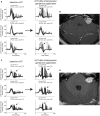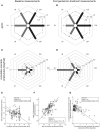Pre-habilitation Before Vestibular Schwannoma Surgery-Impact of Intratympanal Gentamicin Application on the Vestibulo-Ocular Reflex
- PMID: 33633676
- PMCID: PMC7902035
- DOI: 10.3389/fneur.2021.633356
Pre-habilitation Before Vestibular Schwannoma Surgery-Impact of Intratympanal Gentamicin Application on the Vestibulo-Ocular Reflex
Abstract
Background: Patients with vestibular schwannoma that show residual peripheral-vestibular function before surgery may experience sudden and substantial vestibular loss of function after surgical resection. To alleviate the sudden loss of peripheral-vestibular function after vestibular-schwannoma (VS) resection, pre-surgical intratympanic gentamicin application was proposed. Objective: We hypothesized that this approach allows for a controlled reduction of peripheral-vestibular function before surgery but that resulting peripheral-vestibular deficits may be canal-specific with anterior-canal sparing as observed previously in systemic gentamicin application. Methods: Thirty-four patients (age-range = 27-70 y) with unilateral VS (size = 2-50 mm) were included in this retrospective single-center trial. The angular vestibulo-ocular reflex (aVOR) was quantified before and after (29.7 ± 18.7 d, mean ± 1SD) a single or two sequential intratympanic gentamicin applications by use of video-head-impulse testing. Both aVOR gains, cumulative saccadic amplitudes, and overall aVOR function were retrieved. Statistical analysis was done using a generalized linear model. Results: At baseline, loss of function of the horizontal (20/34) and posterior (21/34) canal was significantly (p < 0.001) more frequent than that of the anterior canal (5/34). After gentamicin application, loss of function of the horizontal (32/34) or posterior (31/34) canal remained significantly (p ≤ 0.003) more frequent than that of the anterior canal (18/34). For all ipsilesional canals, significant aVOR-gain reductions and cumulative-saccadic-amplitude increases were noted after gentamicin. For the horizontal canal, loss of function was significantly larger (increase in cumulative-saccadic-amplitude: 1.6 ± 2.0 vs. 0.8 ± 1.2, p = 0.007) or showed a trend to larger changes (decrease in aVOR-gain: 0.24 ± 0.22 vs. 0.13 ± 0.29, p = 0.069) than for the anterior canal. Conclusions: Intratympanic gentamicin application resulted in a substantial reduction in peripheral-vestibular function in all three ipsilesional canals. Relative sparing of anterior-canal function noted at baseline was preserved after gentamicin treatment. Thus, pre-surgical intratympanic gentamicin is a suitable preparatory procedure for reducing the drop in peripheral-vestibular function after VS-resection. The reasons for relative sparing of the anterior canal remain unclear.
Keywords: aminoglycosides; anterior-canal sparing; tumor size; vestibulotoxicity; video-head-impulse testing.
Copyright © 2021 Tarnutzer, Bockisch, Buffone, Huber, Wettstein and Weber.
Conflict of interest statement
KW was supported by the Swiss National Science Foundation (320030_166346) and the Uniscientia Stiftung, Vaduz, Liechtenstein. He acts as an unpaid consultant and has received funding for travel from Otometrics. The remaining authors declare that the research was conducted in the absence of any commercial or financial relationships that could be construed as a potential conflict of interest.
Figures



Similar articles
-
Changes in the three-dimensional angular vestibulo-ocular reflex following intratympanic gentamicin for Ménière's disease.J Assoc Res Otolaryngol. 2002 Dec;3(4):430-43. doi: 10.1007/s101620010053. Epub 2002 Mar 26. J Assoc Res Otolaryngol. 2002. PMID: 12486598 Free PMC article.
-
Two conditions to fully recover dynamic canal function in unilateral peripheral vestibular hypofunction patients.J Vestib Res. 2021;31(5):407-421. doi: 10.3233/VES-201557. J Vestib Res. 2021. PMID: 33749626
-
Vergence-mediated modulation of the human angular vestibulo-ocular reflex is unaffected by canal plugging.Exp Brain Res. 2008 Apr;186(4):581-7. doi: 10.1007/s00221-007-1262-z. Epub 2008 Jan 9. Exp Brain Res. 2008. PMID: 18188548
-
Bilateral vestibulopathy.Handb Clin Neurol. 2016;137:235-40. doi: 10.1016/B978-0-444-63437-5.00017-0. Handb Clin Neurol. 2016. PMID: 27638075 Review.
-
Vestibulotoxicity Associated With Platinum-Based Chemotherapy in Survivors of Cancer: A Scoping Review.Front Oncol. 2018 Sep 25;8:363. doi: 10.3389/fonc.2018.00363. eCollection 2018. Front Oncol. 2018. PMID: 30319960 Free PMC article.
Cited by
-
Labyrinthectomy Improves Dizziness in Patients with Vestibular Schwannoma.J Neurol Surg B Skull Base. 2024 Jul 24;86(4):395-402. doi: 10.1055/a-2360-9474. eCollection 2025 Aug. J Neurol Surg B Skull Base. 2024. PMID: 40620627 Free PMC article.
-
Vestibular Prehabilitation-A Single UK Center Experience and Literature Review.J Neurol Surg B Skull Base. 2023 Nov 24;85(Suppl 2):e46-e49. doi: 10.1055/a-2198-8205. eCollection 2024 Oct. J Neurol Surg B Skull Base. 2023. PMID: 39444774 Free PMC article.
-
Subjective perception of activity level: A prognostic factor for developing chronic dizziness after vestibular schwannoma resection?Front Neurol. 2022 Aug 19;13:925801. doi: 10.3389/fneur.2022.925801. eCollection 2022. Front Neurol. 2022. PMID: 36062005 Free PMC article.
-
The comparison between intratympanic gentamicin prehabilitation and postoperative virtual reality exposure to standard vestibular training in patients with vestibular schwannoma.Eur Arch Otorhinolaryngol. 2025 Jan;282(1):79-89. doi: 10.1007/s00405-024-08891-8. Epub 2024 Aug 10. Eur Arch Otorhinolaryngol. 2025. PMID: 39127800 Free PMC article.
-
[The application value of video head impulse test, caloric test and dizziness handicap inventory in the diagnosis of acoustic neuroma].Lin Chuang Er Bi Yan Hou Tou Jing Wai Ke Za Zhi. 2022 Aug;36(8):613-616. doi: 10.13201/j.issn.2096-7993.2022.08.009. Lin Chuang Er Bi Yan Hou Tou Jing Wai Ke Za Zhi. 2022. PMID: 35959580 Free PMC article. Chinese.
References
-
- Hadjipanayis CG, Carlson ML, Link MJ, Rayan TA, Parish J, Atkins T, et al. . Congress of neurological surgeons systematic review and evidence-based guidelines on surgical resection for the treatment of patients with vestibular schwannomas. Neurosurgery. (2018) 82:E40–3. 10.1093/neuros/nyx512 - DOI - PubMed
LinkOut - more resources
Full Text Sources
Other Literature Sources

